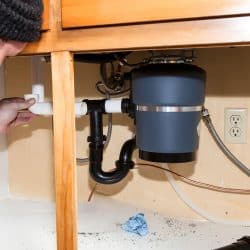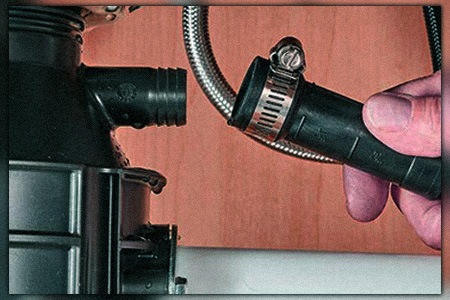Quick Solutions for Fixing a Dripping Waste Disposal Unit
Quick Solutions for Fixing a Dripping Waste Disposal Unit
Blog Article
The publisher is making several good annotation relating to Why Is My Garbage Disposal Leaking From the Bottom? as a whole in this article which follows.

Waste disposal unit are essential cooking area home appliances that aid in throwing away food waste efficiently. Nonetheless, a dripping garbage disposal can be a discouraging and messy issue to deal with. Luckily, many leakages can be fixed quickly with a couple of straightforward actions. In this write-up, we will certainly review just how to take care of a dripping waste disposal unit successfully.
Intro
Garbage disposals are set up under cooking area sinks and are designed to shred food waste right into smaller sized items, allowing it to pass through the pipes system quickly. While these devices are normally trusted, leakages can occur with time as a result of damage, loose links, or damage to the unit.
Usual Sources Of Leaks in Waste Disposals
Worn Seals and Gaskets
Seals and gaskets play a crucial function in protecting against water from dripping out of the garbage disposal. Over time, these components can deteriorate, resulting in leakages around the disposal unit.
Loose Connections
The connections between the garbage disposal and the plumbing system can become loose in time, causing water to leak out throughout procedure.
Cracks or Holes in the Disposal Unit
Physical damage to the garbage disposal, such as cracks or holes in the housing, can additionally lead to leakages.
Identifying the Source of the Leakage
Prior to attempting to repair a leaking garbage disposal, it is essential to recognize the resource of the leak. This can commonly be done with visual examination or by performing straightforward examinations.
Visual Inspection
Check the garbage disposal system carefully for any type of indicators of water leak. Pay attention to areas around seals, gaskets, and link factors.
Evaluating for Leakages
One way to examine for leaks is by running water via the disposal unit and checking for any kind of noticeable indications of leakage.
Tools and Products Needed for Repairing a Dripping Waste Disposal Unit
Before beginning the repair service procedure, collect the essential devices and products, consisting of a screwdriver, adjustable wrench, plumber's putty, substitute seals or gaskets, and epoxy or patching material for repairing splits or openings.
Step-by-Step Overview to Dealing With a Leaking Garbage Disposal
Switch off the Power
Before attempting any kind of repair services, ensure that the power to the waste disposal unit device is shut off to stop the threat of electric shock.
Find the Leak
Identify the specific area of the leakage and figure out the cause.
Tighten Links
Make use of a wrench to tighten any loosened links between the disposal system and the pipes system.
Change Seals or Gaskets
If the leak results from used seals or gaskets, get rid of the old components and replace them with new ones.
Patching Cracks or Holes
For cracks or holes in the disposal system, use epoxy or a suitable patching product to seal the broken location.
Checking the Garbage Disposal After Repair
As soon as the fixing is complete, examine the garbage disposal by running water with it to make certain that the leak has actually been dealt with.
Preventive Upkeep Tips to Stay Clear Of Future Leaks
To avoid future leakages, it is important to perform routine upkeep on your garbage disposal. This consists of maintaining it clean, preventing placing non-food items or difficult items down the disposal, and regularly looking for leaks or various other problems.
Verdict
In conclusion, repairing a dripping garbage disposal is a fairly straightforward process that can be finished with basic tools and products. By adhering to the actions described in this article and exercising preventative maintenance, you can maintain your waste disposal unit in good working condition and avoid expensive repair services in the future.
HERE’S HOW TO FIX YOUR GARBAGE DISPOSAL
WHAT TO DO IF SOMETHING IS STUCK IN YOUR GARBAGE DISPOSAL
If the impeller won’t turn, there’s probably something stuck in the disposal. It could be a steak bone or peach pit, although plumbers report pulling all sorts of inappropriate objects out of disposals, such as bottle caps or aluminum foil. Make sure power to the disposal is off, and look inside to see if you can see the source of the jam.
Never stick your fingers in a disposal. Pull out anything you see with tongs or pliers.
If the disposal still won’t work, it may be time to call a plumber or consider buying a new disposal. GEM Plumbing & Heating is here for all of your garbage disposal needs.
WHAT TO DO IF YOUR GARBAGE DISPOSAL DRAIN IS CLOGGED
Take everything out from underneath your sink and put a bucket or other container under your disposal to catch any water that drains out. Disconnect your disposal from the power supply. If it’s plugged into a wall outlet, unplug it. If it’s hardwired into an electrical box, go to the electrical panel and turn off the breaker for the disposal. Pour ¼ cup of baking soda into the drain, followed by ½ cup of white vinegar. Give the solution a few minutes to fizz and do its work. Look into the disposal with a flashlight to see if you can see an object that might be causing the clog. If you see it, remove it using tongs or pliers. MORE TIPS ON DEALING WITH A CLOGGED GARBAGE DISPOSAL
Never use drain cleaner in a garbage disposal. It can damage the plastic parts inside the disposal. You can also be splashed with the caustic liquid while working to clear the clog. Beware! Never stick your fingers into a garbage disposal. Trust us — not a good idea. In many instances, your dishwasher drains through your garbage disposal. This allows the disposal to grind any large food particles that may be drained out of your dishwasher. There are some jurisdictions, however, where the plumbing code prohibits such a connection. WHAT TO DO WHEN YOUR DISHWASHER DRAINS THROUGH THE DISPOSAL
Run some water in the sink so your plunger has at least a ½-inch of water to create a seal and plunge vigorously up and down several times. You may need to repeat this several times. Run hot water down the drain to clear any residue that remains.

I hope you liked our article about Why Is . Thanks a ton for taking a few minutes to browse our article. If you please take the time to distribute this page if you enjoyed it. Thank you so much for going through it.
Click Here Report this page